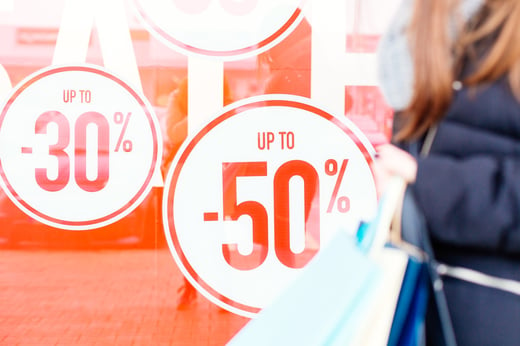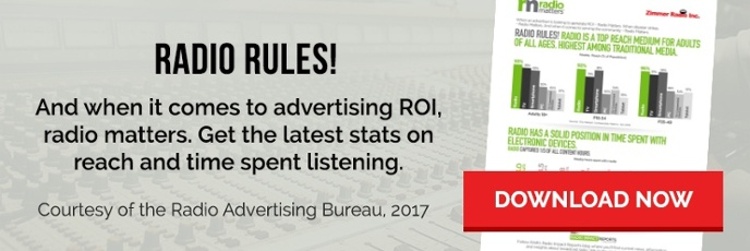 Let’s do a thought exercise: A consumer wants to obtain a particular product, and they do the research to determine which brand they’d like to buy and which store to buy it from. They find it’s available from their favorite store, but while they want it right now, they know the store consistently runs regular discounts. Instead of buying it now, they wait until the next discount kicks in so they can buy it for a cheaper price. In this exercise, most of the advertising for the product brand and store worked. The consumer is successfully converted, the product solves their pain points and desires, and a sale is made. So what’s the problem?
Let’s do a thought exercise: A consumer wants to obtain a particular product, and they do the research to determine which brand they’d like to buy and which store to buy it from. They find it’s available from their favorite store, but while they want it right now, they know the store consistently runs regular discounts. Instead of buying it now, they wait until the next discount kicks in so they can buy it for a cheaper price. In this exercise, most of the advertising for the product brand and store worked. The consumer is successfully converted, the product solves their pain points and desires, and a sale is made. So what’s the problem?
The retailer has trained its customers to wait for discounts, and the profits are marginalized while devaluing their products and services from the customer’s perspective. It can make it seem like your brand doesn’t have confidence in its offerings, or worse, that your brand is untrustworthy. They might take the discount, but that doesn’t mean they’ll come back. Don’t think that this problem is limited to retail, either. No matter what industry you’re in or what business model you use, using discounts too often without a clear and decisive strategy can train your customers and clients to do the same thing.
Current Shopping Behavior
You already know why a business would run a discount — they want to attract new customers, bring regular customers back in, and make more sales. But doing this without understanding the underlying psychology is part of what keys into training them to wait for price drops. The driving force is defined by regulatory focus theory (or the pleasure principle), wherein people seek pleasure and avoid pain. Missing a discount and paying more is the pain to avoid, while saving money and getting the product or service they want is a pleasure. In fact, shopping presents a reward that triggers a dopamine response in the brain, especially when scoring a discount. In a very real way, overusing discounts can firmly entrench shoppers with the desire to wait in order to maximize how happy they feel about their purchase.
This was exacerbated by the Great Recession, when shoppers needed to find the best deals in order to make the best of a tight budget. That’s led to habits you need to consider when developing a strategy:
- 83% of consumers want in-store promotions, and another 81% want steep discounts.
- 76% of Gen Z and 86% of Millennials, and leading-edge Gen X (through age 45) say discounts are influential on purchase decisions.
- 83% of affluent shoppers make their in-store purchase decisions based on discounts.
- 94% of female shoppers in the U.S. say they rarely or very rarely buy clothing if there isn’t a discount involved in the purchase.
- 40% of consumers want the lowest price automatically (i.e., without having to expressly look for discounts).
- 64% of consumers shopping online will wait for items to go on sale.
- 22% will only purchase from their favorite brands when there’s a discount (via sale or coupon).
How Businesses Condition Customers to Wait and Buy Cheaper
In the modern marketplace, it seems like everyone offers discounts, and to be frank, that’s part of the problem. Brands develop a race to the bottom, or the race to be first, and shoppers learn to watch and wait to get what they want at the cheapest possible price. Here are some of the tactics that drive this inadvertent training.
Running Discounts Too Often
Have you ever received a Bed, Bath, & Beyond flier in the mail? Chances are you’ve gotten many, and you’ve gotten them regularly, each promoting major discounts throughout the store. The company ran into a major problem where customers wouldn’t come to shop without that discount, and because the sales happened so often, there were very few products they’d miss out on getting at a lower price. There was never a good reason to come in while everything was at full price.
Promoting Discounts Too Early
Maybe you don’t run discounts as excessively as in our last point, but in order to be top of mind early in your customer’s decision process, you start advertising your discounts farther and farther in advance. To a point, this seems to work; you do get their attention early, and they do come in for the sale. The problem is that they’re less likely to come in before the discount occurs. They know there’s going to be a sale, so they might as well wait. You’re losing out on the full-price purchases they would have made in the meantime.
Discounting Too Many Products and Services
A storewide discount is very attractive to customers; after all, it provides incredible savings on anything they might want or need. Unfortunately, that means everything they buy cuts into your bottom line, instead of making money back on the full-price items they probably would have bought with the discounted purchase anyway.
Always Discounting the Same Products and Services
Predictability makes your brand dependable, but you can depend on predictable discounts to hurt your profit margins. Customers will start to stock up on those products or get as much service as possible while the discount is active in order to hold out until the discount is available again. These will eventually become a serious drain on your company.
Saving a Sale with a Discount
Being a salesperson is a tough job, and it requires a balancing act of giving the customer what they want and convincing them they want what you’re offering. At some point in the discussion, the salesperson will realize that they’re not going to close the deal, so they reach for the easiest thing they think will tip the balances — a discount. If the customer’s told they’re getting the very best package at the very best price, but suddenly there’s a discount, this makes it sound like your brand was holding out, and the “normal” price isn’t a good price. It may make them question whether or not everything else the salesperson said was a trumped up sales pitch.
Tips to Avoid It
Since 75% of businesses are slicing their margins in order to offer discounts, your company needs to be able to find a way to offer value and promotions to be competitive without undercutting your bottom line. We’ve put together a list of tips to help you develop a truly winning strategy.
Plan Ahead to Use Discounts More Precisely.
By building discounts into your overall Joplin advertising strategy, you can decidedly pick and choose when to run discounts, when to promote those discounts, and exactly what you’d like to discount. Don’t spread it across the whole store, but apply it to particular items that will attract attention without impinging on your margins too much. Be sure you’re not constantly running discounts, or letting discounts run back to back.
Don’t Make Discounts Too Steep.
Customers may like steep discounts, but that doesn’t mean you have to break your business to provide them. Planning ahead also allows you to take a look at your cash flow forecasting in order to determine what kind of discount won’t hurt your bottom line. This can be useful during known slow periods, when a sale might generate more foot traffic than you’d see otherwise.
Promote Discounts in a Way that Engenders Urgency.
Instead of promoting a long time in advance, do a shorter marketing push that makes the discount seem special and limited. Coupled with a short run time, this makes the process more exciting and rewarding for the consumer with less risk to your business.
Leverage Loss Leaders Wisely.
A loss leader is a sale of a particular product or service at a loss to attract people to a brand. The low price on this one thing brings people to a brand (usually a store), where they purchase plenty of other things at regular price. If it’s used correctly, the cost to you from the loss leader is part of the cost of customer acquisition. However, you’ll need other strategies in play to generate repeat visits and loyalty.
Give Different Discounts to Different People.
With targeted advertising — especially email lists and loyalty programs — you can provide meaningful and even personalized discounts to individuals based on their habits or interests. What’s more, if you utilize the right tracking and code, you can provide discounts to new customers that aren’t seen by current customers. By differentiating who gets what discount and when, you can minimize the impact to your company while providing value.
Promotions Don’t Have to Be Discounts.
Discounts are influential on purchase decisions because customers want to get the most for their money. However, in many cases, they’re still willing to pay more for excellent service and great value. Other types of promotions, like bundles or free-with-purchase items, provide that value without slicing into your margins.
Always Put Value Over Price.
Ultimately, the reason people make purchases from your brand needs to be the value you provide them. There are very successful businesses that feel that running any discounts is bad for business and refuse to use them because the value they already offer customers is that great. It’s a valid way to approach business, but it may or may not be right for your company. If you do use discounts, you want them to feel like a bonus to the customer, not the only reason they’re there.
Reevaluate Your Regular Pricing.
When you evaluate your profit margins, make sure you evaluate why you’re charging what you’re charging for particular things, especially if they only ever sell when they’re discounted. It’s possible these items are overpriced, and people simply won’t buy them at that price. You may need to adjust your pricing structure, rather than constantly run discounts.
When you’re developing your Joplin marketing strategy and schedule, remember that discounts should not be your predominant method for drawing customers to your brand. Value and quality are much stronger motivators that will build dependable loyalty. Use the tips we’ve laid out above to ensure that your promotions grow your brand rather than undermine it.

